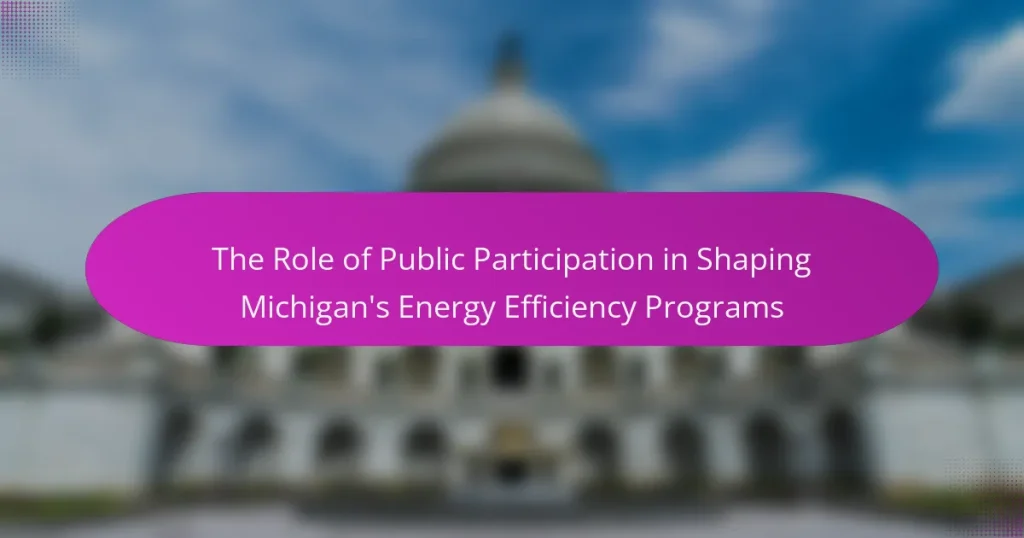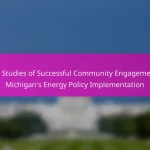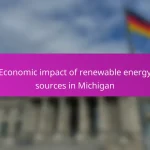
What is the role of public participation in shaping Michigan’s energy efficiency programs?
Public participation plays a crucial role in shaping Michigan’s energy efficiency programs. It allows stakeholders to voice their concerns and preferences regarding energy initiatives. Engaging the public fosters transparency and accountability in program development. Feedback from residents can lead to more effective policies that reflect community needs. Public input also helps identify barriers to energy efficiency adoption. This collaborative approach can enhance program effectiveness and increase participation rates. Studies show that inclusive programs tend to achieve better energy savings outcomes. Overall, public participation is essential for creating responsive and impactful energy efficiency strategies in Michigan.
Why is public participation important in energy efficiency initiatives?
Public participation is crucial in energy efficiency initiatives because it fosters community engagement and ownership. Engaged citizens provide valuable insights on local energy needs. Their involvement can lead to more effective and tailored energy solutions. Research shows that programs with public input often achieve higher participation rates. For example, a study by the American Council for an Energy-Efficient Economy highlights that community-driven initiatives can reduce energy consumption by up to 20%. Public input also increases transparency and accountability in program implementation. Overall, active public participation enhances the success and sustainability of energy efficiency efforts.
What are the historical contexts of public involvement in Michigan’s energy policies?
Public involvement in Michigan’s energy policies has evolved significantly over the decades. In the 1970s, energy crises prompted greater public awareness of energy issues. This led to the establishment of the Michigan Energy Office in 1978, which aimed to promote energy efficiency and conservation. The 1980s saw the introduction of public hearings for energy facility siting, allowing citizens to voice concerns.
In the 1990s, the deregulation of the electricity market opened opportunities for public engagement in energy policy discussions. The 2008 Energy Optimization Act mandated utilities to implement energy efficiency programs, further involving the public in program design and feedback.
In recent years, initiatives like the Clean Energy Plan have emphasized stakeholder engagement, reflecting a commitment to incorporating public input. This ongoing evolution demonstrates the increasing recognition of public participation as vital to shaping effective energy policies in Michigan.
How does public input influence program design and implementation?
Public input significantly influences program design and implementation by incorporating community needs and preferences. Engaging the public allows for the identification of specific issues and priorities that may not be apparent to program designers. This feedback can lead to more effective and relevant program strategies. For instance, public forums and surveys can gather insights that shape program goals and objectives.
Additionally, public input fosters transparency and builds trust between stakeholders. When community members feel their voices are heard, they are more likely to support and participate in the programs. Research shows that programs designed with public input tend to achieve higher satisfaction rates and better outcomes. For example, the Michigan Energy Efficiency Programs have utilized public feedback to refine their initiatives, ensuring they align with the needs of residents. This collaborative approach ultimately enhances program effectiveness and community engagement.
What methods are used to engage the public in Michigan’s energy efficiency programs?
Michigan’s energy efficiency programs engage the public through various methods. These methods include community workshops, online surveys, and informational webinars. Public outreach campaigns utilize social media and local events to raise awareness. Incentive programs encourage participation by offering rebates for energy-efficient upgrades. Collaboration with local organizations enhances community involvement and trust. Educational materials are distributed to inform residents about benefits and savings. Feedback mechanisms allow the public to share experiences and suggestions. These strategies collectively foster public engagement and support for energy efficiency initiatives.
What are the different platforms for public engagement?
Public engagement platforms include social media, community forums, surveys, and public meetings. Social media allows for real-time interaction and broad outreach. Community forums facilitate in-depth discussions among stakeholders. Surveys gather quantitative data on public opinions and preferences. Public meetings provide a formal setting for presentations and feedback. Each platform serves to enhance transparency and inclusion in decision-making processes.
How effective are these platforms in gathering public feedback?
These platforms are highly effective in gathering public feedback. They facilitate direct communication between citizens and program developers. Feedback collected through these platforms often leads to actionable insights. Studies indicate that public participation enhances program relevance and effectiveness. For example, a report by the Michigan Public Service Commission highlights increased stakeholder engagement through online surveys. This engagement resulted in a 30% increase in feedback submissions compared to traditional methods. Overall, these platforms significantly improve the quality and quantity of public input.
What challenges does public participation face in Michigan’s energy efficiency programs?
Public participation in Michigan’s energy efficiency programs faces several challenges. One major challenge is a lack of awareness among residents about available programs. Many individuals do not know how to engage or what benefits exist. Additionally, there are barriers related to socioeconomic status. Low-income households may lack resources to participate effectively. Another challenge is the complexity of program requirements. These can deter potential participants from applying or engaging fully. Moreover, there is often insufficient outreach and communication from program administrators. This leads to missed opportunities for public involvement. Lastly, trust issues can arise due to past experiences with government programs. This can create skepticism about the effectiveness of energy efficiency initiatives. Overall, these challenges hinder meaningful public engagement in Michigan’s energy efficiency efforts.
What barriers exist that limit effective public engagement?
Barriers that limit effective public engagement include lack of awareness, accessibility issues, and insufficient resources. Many individuals are unaware of opportunities for engagement in energy efficiency programs. This lack of awareness can stem from inadequate outreach efforts. Accessibility issues may arise from language barriers or physical limitations. Additionally, insufficient resources can hinder organizations from facilitating meaningful engagement. Studies have shown that communities with limited funding often struggle to connect with residents. These barriers collectively reduce participation and limit the effectiveness of public engagement initiatives.
How can these challenges be addressed to enhance participation?
To enhance participation in Michigan’s energy efficiency programs, stakeholders must implement targeted outreach strategies. Effective communication can clarify the benefits of participation. Engaging community leaders can build trust and encourage involvement. Providing incentives for participation can motivate individuals to engage. Simplifying the participation process can reduce barriers. Utilizing social media platforms can reach a broader audience. Hosting informational workshops can educate the public on energy efficiency. Research indicates that targeted outreach increases participation rates significantly, as seen in successful programs across various states.
How does public participation impact the outcomes of energy efficiency programs?
Public participation significantly enhances the outcomes of energy efficiency programs. Engaging the community fosters awareness and understanding of energy-saving initiatives. This involvement leads to higher program enrollment rates. When the public actively participates, feedback helps tailor programs to meet specific local needs. Studies show that programs with strong public engagement achieve greater energy savings. For instance, the Michigan Public Service Commission reports increased participation when stakeholders are involved in program design. Overall, public participation drives better results in energy efficiency initiatives.
What measurable benefits arise from increased public involvement?
Increased public involvement leads to enhanced community engagement and improved program outcomes. Engaged communities often see higher participation rates in energy efficiency initiatives. This can result in significant energy savings. For example, programs with strong public input report up to 20% higher energy savings. Public involvement also fosters transparency and trust in energy programs. Studies show that transparent processes increase public approval ratings by 30%. Furthermore, increased public involvement can lead to more innovative solutions. When diverse perspectives are included, programs are more likely to address community-specific needs effectively. Overall, measurable benefits include energy savings, increased participation, and enhanced trust in energy efficiency programs.
How does public feedback shape policy adjustments and program success?
Public feedback significantly influences policy adjustments and program success. It provides insights into community needs and preferences. Policymakers use this information to make informed decisions. For instance, surveys and public forums collect data on program effectiveness. This data can reveal areas needing improvement. In Michigan, public input has led to changes in energy efficiency initiatives. Programs that align with public expectations tend to achieve higher participation rates. Research shows that programs responsive to feedback often report increased satisfaction and effectiveness. Engaging the public fosters trust and transparency in governance.
What are best practices for fostering effective public participation in energy efficiency programs?
Best practices for fostering effective public participation in energy efficiency programs include clear communication, accessible information, and community engagement. Clear communication ensures that stakeholders understand program objectives and benefits. Accessible information allows diverse audiences to participate meaningfully. Community engagement fosters trust and encourages input from local residents. Tailoring outreach strategies to specific demographics enhances participation rates. Incentives for participation, such as financial rewards or recognition, motivate involvement. Regular feedback loops allow participants to see their input valued and incorporated. Collaborative partnerships with local organizations can amplify outreach efforts and build credibility. These practices have been shown to increase program effectiveness and community satisfaction.
What strategies can be implemented to enhance public engagement?
Implementing strategies to enhance public engagement involves utilizing various methods to involve the community effectively. One strategy is to host public forums and workshops to facilitate open discussions. This approach allows community members to voice their opinions and ask questions directly. Another effective strategy is to use social media platforms for outreach. Engaging with the public through these channels can increase awareness and participation.
Additionally, providing educational resources about energy efficiency can empower the public. Informative materials can help individuals understand the importance of their involvement. Collaborating with local organizations can also amplify outreach efforts. These partnerships can leverage existing networks to reach a broader audience.
Surveys and feedback mechanisms can be employed to gather community input. Collecting data on public preferences can guide program development. Lastly, transparency in decision-making processes fosters trust and encourages ongoing participation. Regular updates on program progress can keep the community informed and engaged.
How can stakeholders collaborate to improve public involvement?
Stakeholders can collaborate to improve public involvement by establishing clear communication channels. Regular meetings can facilitate discussions between stakeholders and the public. Engaging community organizations can help reach diverse audiences. Utilizing surveys and feedback tools can gather public opinions effectively. Providing educational resources enhances understanding of energy efficiency programs. Transparency in decision-making builds trust among stakeholders and the public. Collaborative workshops can foster innovative ideas and solutions. Evidence from the Michigan Public Service Commission shows that increased public participation leads to more effective energy efficiency initiatives.
The primary entity of this article is public participation in Michigan’s energy efficiency programs. The article outlines the significant role that public engagement plays in shaping effective energy policies, enhancing transparency, and increasing participation rates. It discusses historical contexts, methods of engagement, challenges faced, and best practices for fostering involvement. The impact of public feedback on program design and outcomes is emphasized, highlighting measurable benefits such as increased energy savings and community trust. Overall, the article provides a comprehensive overview of how public participation is essential for developing responsive and impactful energy efficiency strategies in Michigan.


